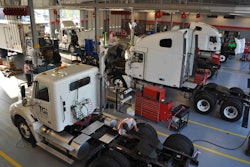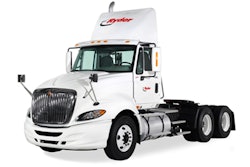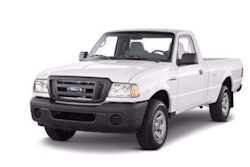
HWT: Are all Ryder vehicles equipped with a tire monitoring system?
Perry: No, I wish that were the case, but we have so many different brands of vehicles that are manufactured, and many of those OEMs don’t have an integrated solution, so we’ve had to do some aftermarket installations. We’ve made it standard on our rental trailer fleet, because that’s such a nomadic product—it moves all over the country from a maintenance scheduling standpoint. It may go to a shop two or three times a year, so installing that type of system—the Meritor PSI system for tire inflation monitoring—helps us eliminate tire failures and premature tire loss and it improves uptime. But that’s the only piece of our fleet that we’ve made it standard on because of that unique duty cycle. But I would expect that as the technology evolves we’ll be making decisions to make that more of a standard application for us.
HWT: How many times, ideally, is tire pressure being checked?
Perry: In the case of a customer that’s fueling with us and they’re coming across one of our service islands, every two or three days. That’s one of the key steps that we take. Our Ryder system network and our fuel system network is fully attended. So we have personnel that man that and that’s one of the key benefits that our customers get coming across our fuel islands is that we’re doing tire pressure checks of all wheel positions while the vehicle is being fueled. So every time he comes across a service island we’re looking at the tires, checking the tire pressure, making sure there’s not any damage that’s occurred to them that needs to be part of a service event. But that’s the step we take every time they fuel the vehicle with us. Every time it comes into one of our service bays, it’s one of the first things that we do is check the tire inflation and we also spend a lot of time with our customers training the drivers and we’ll provide them with tire gauges for them to use as part of a pre-trip inspection and hoping that they’re monitoring that tire inflation very actively, too.
Perry (con’t): The recommendation for compliance for GHG Phase 2 is the automated tire inflation system. So, that’s very, very important. Just having tire monitoring gives you early indication that tire pressure loss is occurring so that action can be taken before you have absolute damage to the tire or to the wheel end or to the wheel itself. Active tire monitoring would be great on every wheel position, but I think it’s going to be a combination of both that we’ll see—tire pressure monitoring and active tire inflation at the same time.
HWT: How about telematics with regards to tire monitoring?
Perry: I think you’re seeing every element of that beginning to converge because with the electronic logging requirements at the end of next year, we see most solutions are going to be telematics based solutions. It will allow for integration of a lot of data that’s coming off the vehicle today—bulk code management for the engine that will be real-time reported and acted upon. But other elements of the vehicle’s safety systems onboard the vehicle will be integrated into that. I think to your point the tire pressure systems will be integrated into that so that you can see real-time what’s occurring and help manage in that event and prevent it from becoming a full-blown failure and road call exercise.
Perry (con’t): If it’s a combination vehicle that’s transporting a refrigerated trailer you’re probably going to have the ability to capture that information via Bluetooth and transmit it on the telematics device as well with regard to the temperature of the refrigerator system and the cargo on board. I think we’re just beginning to scratch the surface of all the information that will come off of the vehicle in the very near future that will help us change how we go about managing the fleet and managing the overall supply chain.
HWT: How big of a role do retreads play with Ryder?
Perry: We’ve been a huge proponent of retreads for a long, long time. And that’s probably one of the biggest driving factors in why we have a primary relationship in that we have set and established very high standards for when a casing can be retreaded and what type of retreading we’ll put back on that tire casing. That’s part of what helps us promote longer tire life and helps us reduce overall running cost for our customers. We’re making that decision of replacing that original tread tire, putting the right retread on it and having some really good quality control efforts, including leveraging technology like shearography. With that we’re taking an x-ray essentially of the casing package, or the belt packing on the casing, to make sure that there’s not damage of the steel belts on the tire that may not be visible to the naked eye but they can be picked up through the shearography, and we’ll take a casing out of service if we have belt damage there. That helps us make sure that we have really high quality casings in our casing banks and those are what we use for our retreading process.
Perry (con’t): The compounding that they’re being developed with is becoming more and more robust. The advent of low-rolling resistance tires—the tread is one thing, the casing also has a lot to do with the overall low rolling resistance of the tire as well. So, we’re very pleased with where we are with Bridgestone and Bandag and their technology, and as I said earlier, we’re a huge proponent of retreading from a sustainability standpoint because there’s such high petroleum content and natural rubber content—that’s a key piece of it—but we also just see that fundamentally, it’s a great lever for us to utilize in managing the tire life.
HWT: Are there disadvantages of changing two tires at a time?
Perry: I think it really depends upon the circumstances for the primary tire failure and what’s led to its destruction. Was it run to a high heat event? Was there any damage that occurred to the mated tire? Even though the mated tire may not be deflated, it may not show symptoms of pending failure. If the mated tire that did fail was run to destruction and generated a significant amount of heat then it’s probably best to replace both tires, because we’ve seen when that occurs that if you don’t action then very soon you’re going to have a second service event and have the vehicle on the side of the road again and you’re going to be replacing that mated tire. So, that’s part of our requirement of whenever we find that that condition has occurred generally we’re making a decision to replace both tires at the same time. Our standard is to replace the damaged tire itself, and part of driver training is that as soon as a tire failure occurs don’t try to continue to drive the vehicle. We understand that there are circumstances sometimes with highway transport and not having access to an exit where the vehicle has to be driven to get it to a safe place, and that’s first and foremost. Sometimes that results in the tire being completely destroyed, but as soon as we can identify a problem as early as possible through active tire pressure monitoring, that will help us manage the event much more successfully.









